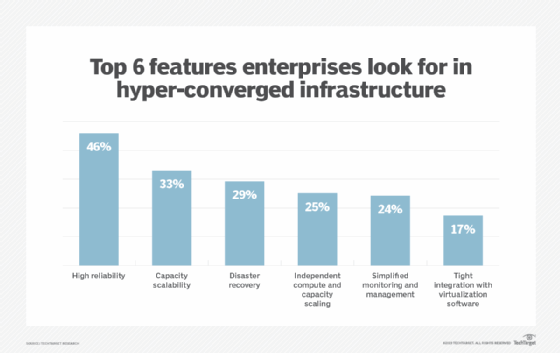
Ronald Hudson - Fotolia
How is HCI market fragmentation affecting buyers, vendors?
An increasingly crowded market and the technological limitations of standard HCI have led to innovative new takes on hyper-convergence to the benefit of vendors and buyers alike.
The HCI market has matured over the last few years, and hyper-convergence is no longer the new kid on the block. A good indicator of the infrastructure paradigm's maturation is the market's recent splintering due to technological innovation.
When hyper-converged infrastructure (HCI) first began to gain popularity, there was a very narrow definition of what qualified as a hyper-converged system. Typically, HCI consisted of compute, storage and network resources combined into a series of modular nodes that were connected to one another by a management layer. At the time, most of the new entries into the HCI market were essentially "same here" offerings.
With so many players entering the HCI market, it was inevitable that the various hyper-converged vendors would begin innovating in an effort to differentiate their platforms from all of the other competing hyper-converged products. This approach -- differentiation through innovation -- has been one of the surest ways for HCI vendors to grow market share.
The flipside to this innovation and differentiation, however, is that although traditional HCI products are still widely available, their days are likely numbered. With vendors trying to win customers by adding new features and capabilities to their products, the industry will soon reach a point at which standard HCI is regarded as unappealing by potential customers.
As such, hyper-converged vendors will have little choice but to continue innovating, leading to further market fragmentation.
Enter HCI 2.0
Innovation has led to what some in the industry are calling HCI 2.0. These are newer hyper-converged products that build on the foundation of first-generation hyper-convergence technology to overcome the latter's shortcomings and expand the HCI market.
With HCI 2.0, for example, composable infrastructure-like disaggregation has come to hyper-convergence. This means, among other things, that these new hyper-converged products often allow users to upgrade and manage storage independently of compute, and vice versa.
With standard hyper-converged hardware, it's often impossible or very difficult to expand server resources independently of one another. So, for instance, you usually can't add more storage capacity without adding more compute power in lockstep -- even if you don't require additional processor performance.
Some newer hyper-converged systems from a number of vendors disassociate compute and storage resources from one another, thereby making it possible to upgrade compute or storage independently. Meanwhile, some HCI vendors, like DataCore, even now enable customers to use not just hyper-convergence's typical integrated storage, but external SAN storage as well.
This type of innovation will likely continue as the HCI market matures further.
Consequences for buyers
From the buyer's standpoint, the splintering of the HCI market is almost entirely a positive thing. The increasing competition among vendors will give hyper-converged customers access to features and capabilities that directly address the pain points of first-generation HCI, while maintaining the benefits that caused buyers to consider hyper-converged technology in the first place.
Furthermore, this increased innovation will likely drive down the total cost of ownership, thereby making HCI even more appealing than it already is.

The only real negative aspect to the splintering of the HCI market for buyers is that researching purchasing decisions will become more difficult. Because hyper-converged products will no longer be substantially similar to one another, this will inhibit an organization's ability to perform feature-by-feature comparisons.
If vendors attempt to rush new products to market, there is also a risk that fragmentation might compromise some of the reliability that hyper-convergence is known for. So far, that has not been a widespread problem, however. We will have to wait and see.





